Seven Famous African-American Masters of American Art - Atlanta Art Gallery
by Maxine E. Davis
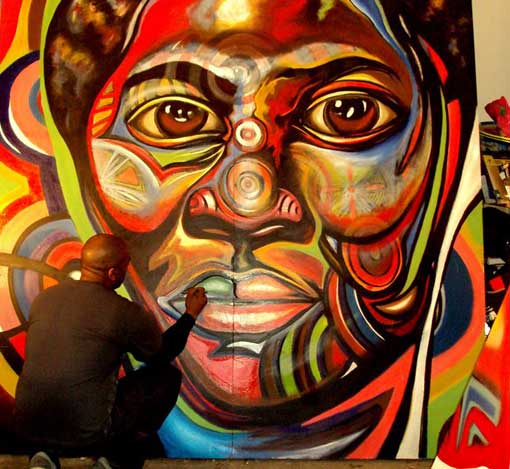 Minority contributions to the cultural heritage of our nation have too often been overlooked and unrecognized in our schools. Minority Artists from Americaõs beginning have made outstanding contributions to American art history. Paintings, sculpture, graphics, and architectural and decorative art objects serve to remind us of the diversity, aesthetic quality and humanistic strength of minority creative efforts through the centuries.
Minority contributions to the cultural heritage of our nation have too often been overlooked and unrecognized in our schools. Minority Artists from Americaõs beginning have made outstanding contributions to American art history. Paintings, sculpture, graphics, and architectural and decorative art objects serve to remind us of the diversity, aesthetic quality and humanistic strength of minority creative efforts through the centuries.
Despite deprivation and adversity, minority artists and crafts people have made outstanding creative contributions that should be an inspiration to us all. This curriculum unit is a survey of contributions made by African Americans. My intent is to help students develop a richer more complete understanding of African-American culture in America.
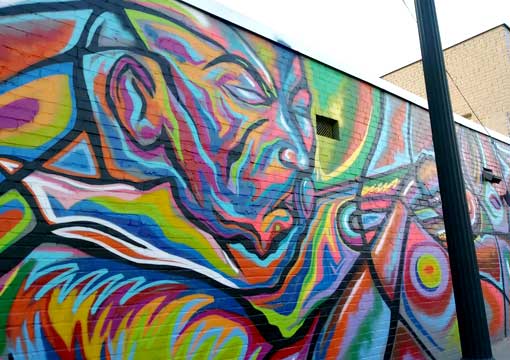
This curriculum unit is designed to introduce middle-school students to the art and visual culture of African-Americans. My goals for the students are: (1) to expose them to a wide range of artistic and cultural expressions among African American artists, (2) to enhance their academic achievement and (3) to help develop positive self-esteem.
The unit will show how African-American culture played an important role in mainstream art history. Through the use of books, photographs, slides, paintings, and visits to art museums, students will examine artistic works of masters of American Art. They will also be able to link artistic expression with traditions of Africa.
In addition, students will engage in discussions, observe art forms, construct murals, compare artists works, and summarize reading assignments. These activities will help students develop an appreciation for rich visual heritage and cultural contributions made by African-Americans
The History of African American Art
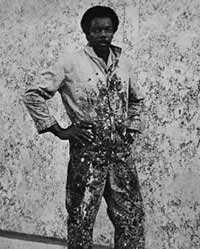 African Americans sold in the early slave markets of the New World were brought mostly from West Africa where the arts were highly developed. Their languages were articulated with such controlled variations of tone and timing that spoken words could easily be made into songs which gained rhythm from measured repetition?a universal folk-device which we know in the blues and spirituals.
African Americans sold in the early slave markets of the New World were brought mostly from West Africa where the arts were highly developed. Their languages were articulated with such controlled variations of tone and timing that spoken words could easily be made into songs which gained rhythm from measured repetition?a universal folk-device which we know in the blues and spirituals.
Wood-carvers, banterers and metalworkers supplied the necessary images, totem animals and other objects; weavers and designers of appliqueõ dressed the gods in fine clothes by making the special costumes required for cult ceremonies. Thus, the products of visual arts were universals in tribal life.
In tracing the antecedents of American art, conventional art histories focus on Egypt, then move northward and eastward through Mesopotamia, Crete, Greece, then to Rome, England, and America. This is one way art influences have reached this country, however it ignores the numerous contributions made by sub-Sahara Africa to American culture. This neglect is tragic in the case of African American youth. One cannot fully understand his present, nor control his future, without knowing something about his past. African Americans have been unaware of their ancestral heritage for too long.
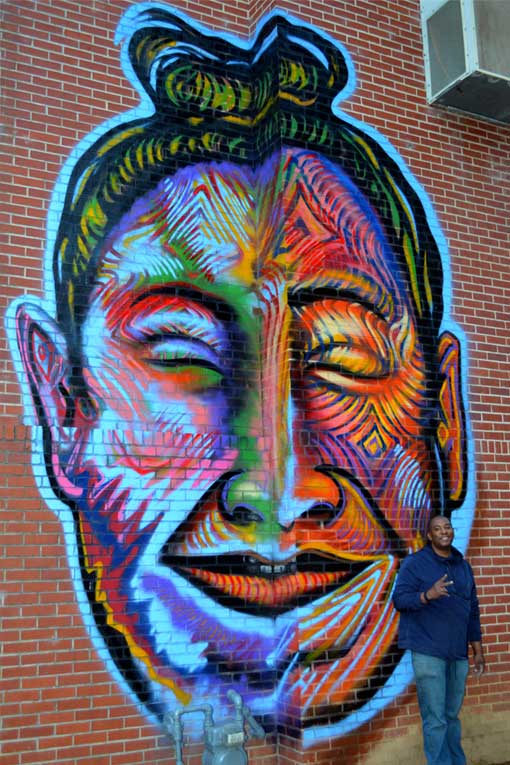
The African interior remained "the dark continent" until the nineteenth century, because it was unexplored and unknown to Europeans. The Christian missions and colonists that followed exploration encouraged a "condescending" attitude toward African culture and did nothing to change popular misconceptions about the continent.
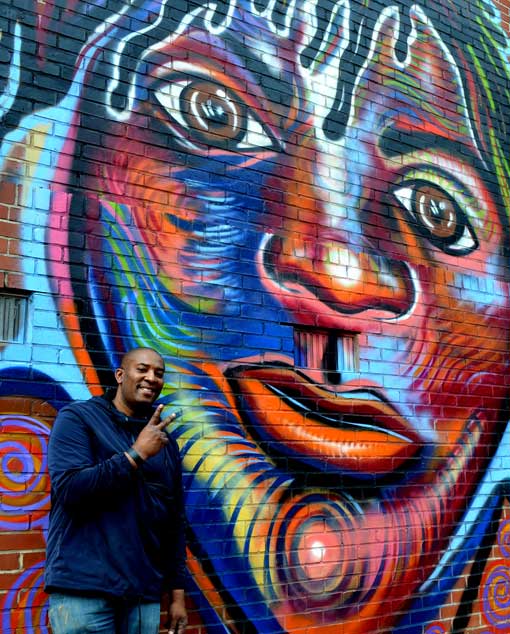
It was not until in recent years that the long history and culture of Black Africa began to be realized. Early travelers accounts had given hints of the fabulous luxury of African kingdoms such as ancient Ghana, but few people read about them. Learning and culture were kept alive in Africa while Europe was obscured in its Dark ages. Although the Atlantic slave trade, and later colonialism were to bring a cultural eclipse to Africa, this cannot erase the fact that there were many highly developed cultures that compared favorably with those of Europe at that time.
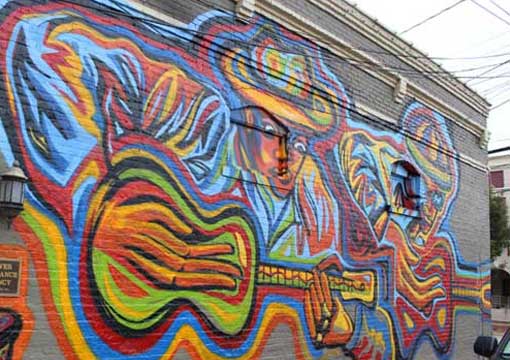
Until the twentieth century, most people believed that the African American had no past worth mentioning. His ancestors came from such scattered parts of Africa that none of his cultural inheritance could have survived. The anthropologist Melville J. Herskovits, who called this misconception "the myth of the Negro past," did much to dispel it in his book of the same name. African American scholars such as Dr. W.E.B. Dubois, Dr. Carter G. Woodson, and Dr. John Hope Franklin also helped to shed light on the African American past.
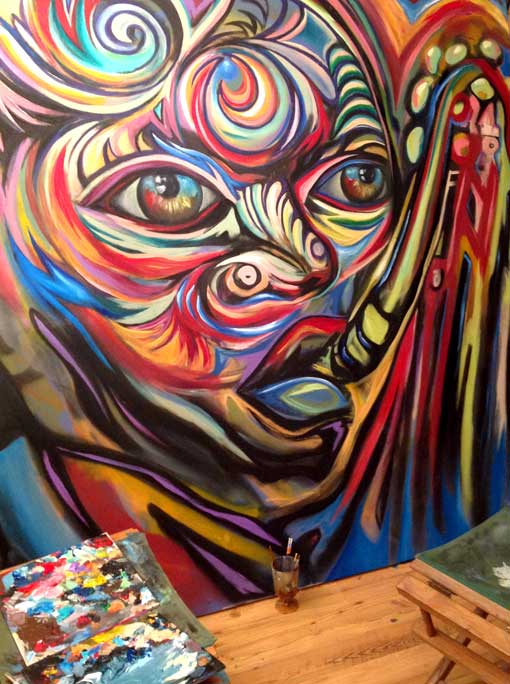
The rise of new African nations and the presence of African diplomats and scholars in this country have created interest in African history and culture. These and other factors have brought about an encouraging change in attitudes and an appreciation for African art forms. In spite, of this knowledge of Africa remains fragmentary and there seems to be little understanding of the full relationship of Africa to American art and culture.
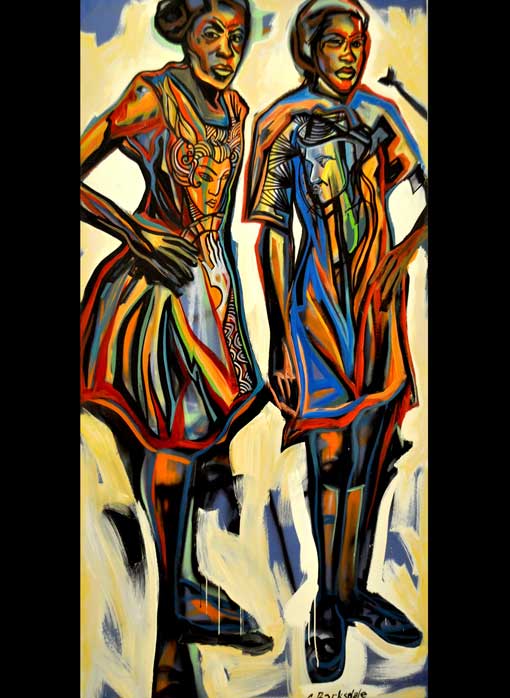
When discussing the cultural traditions brought to this country by African Americans, we must consider the area from which they came. This region was a narrow strip of Atlantic coastline extending from the Senegal River on the north to the southern desert, called the Guinea Coast. The African interior played a minor role in the slave trade. The greatest distance inland from which slaves were brought has been estimated as few hundred miles. A ready supply of slaves was conveniently located close to the coast.
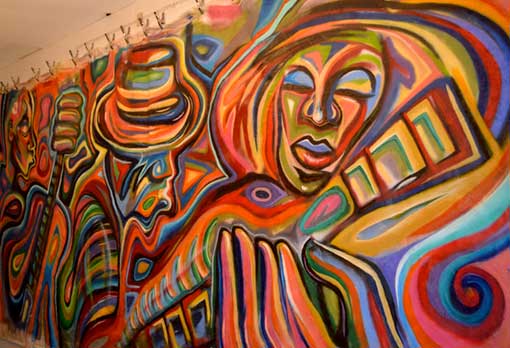
Most African Americans did not reach America via the east coast ports of Africa. The earliest firsthand report of this comes from a Greek mariner's guide, "The Periplus of the Erythraen Sea", written about 60 A.D. From this and other evidence we are told such east coast trading centers as Pemba and Kilwa Islands, traded mainly with eastern markets from the Red Sea to China and Ceylon. The records show that slaves were never a major item of export along this coast until the brief but bloody Arab slave trade from Zanzibar in the nineteenth century. Then, because of the international treaty banning the slave, many slavers from Europe or America sailed around the Cape of Good Hope to avoid men of war patrolling the Guinea Coast. This was so late in the history of the Atlantic slave trade that the number of east coast blacks involved was small.
Although few African peoples were spared some tribute of slaves, it is to the west coast that we look for the major cultural contributions to America. This geographical distinction is extremely important when we consider the artistic achievements of African-Americans The region from which most black slaves were brought was one in which artist-craftsman were highly regarded and where some of the worldõs finest art was produced, including figure sculpture which has made African art famous.
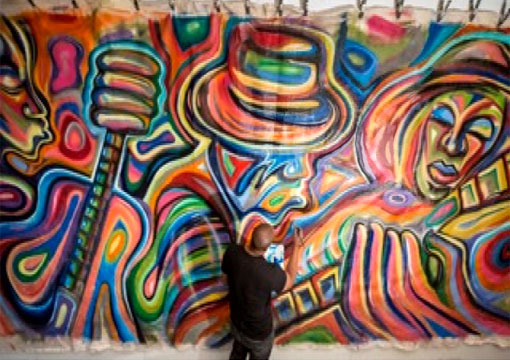
Transplanted to America, the African had less opportunity as well as motivation for artistic expression. Deprived of 3god2 and king, his art no longer served the world of the spirit and he had to content himself with serving man. He did this with skill and with as much creativity as was possible within restrictive bonds of slavery. He was aided by the fact that in Africa his works of art had been bound by traditional patterns and rules. He was accustomed to finding individual ways of expressing himself within bounds.
Although the craftsperson was stripped of his physical possessions and cultural content, the African slave was not be stripped of his talent. He carried with him his expert skills and artist sensitivity. Most importantly, he carried his capacity to adapt to changing circumstances, a quality that resulted in the development of new motives for artistic expression. These were to enrich both his life and the lives European Americans with whom he would make his home.
Art objects such as masks and figure sculpture served religious and social needs of African societies. This need was no longer present in the West-oriented society of the New World. However, creating handicrafts that served a utilitarian purpose was the most common route to creativity open to African American artisan. Although it was a creative outlet, creating handicrafts denied the African-American artisan an important emotional and spiritual means of expression. Centuries past the African had excelled in producing beautiful functional articles for his own use or trade.
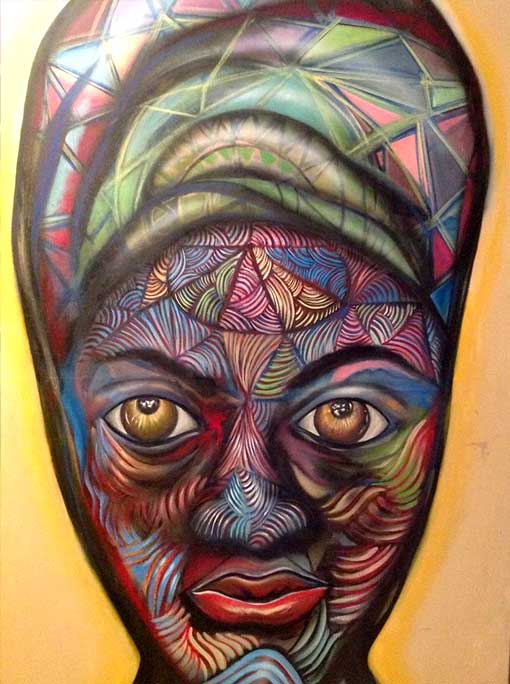
The pre-industrial culture to which the African was first introduced in America held the expert craftsman in great respect. Because of the difficulty of importing goods from Europe, Americans depended on locally made utilitarian objects. Everything was needed and quickly, and the well-trained, highly skilled African craftsmen worked side-by-side with his European counterparts in satisfying that demand.
Although this new culture was alien to the African slave, the work was familiar because the materials available for artistic expression were often identical to those he used in Africa?wood, metal, natural fibers, animal products, clay and many of the old-country techniques could be applied without making changes. The African artist-craftsman also assimilated European ideas and techniques and melded them with those of his forefathers.
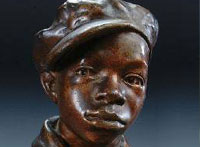 The process of creative synthesis continued in this country as it had across the ocean, where the African had borrowed much from other cultures. He borrowed from conqueror, conquered, from new neighbors or traders and ancestors. He also invented. Through this invention and adaptation, he developed new cultures of his own.
The process of creative synthesis continued in this country as it had across the ocean, where the African had borrowed much from other cultures. He borrowed from conqueror, conquered, from new neighbors or traders and ancestors. He also invented. Through this invention and adaptation, he developed new cultures of his own.
As early as the eighteenth century records show African Americans, both slave and free, worked in the fields of painting, woodcarving, gold or silversmithing, engraving or wood-block printing. Although, these vocations were regarded as functional at the time, they offered more scope for the creative talents of the artist-craftsman than did making of articles for use for the plantation.
As the nineteenth century wore on, more African Americans became distinguished painters and sculptors, however few achieved the recognition or acceptance which they deserved. Most of them experienced racial bias. Some were so embittered by racism that they became expatriates. Despite difficulties encountered by all artists everywhere, and the additional handicap of racism, they succeeded to a remarkable degree.
The works of these artists followed the mainstream of art. At first, it was somewhat stiff and formal and later over-sentimentalized. This reflected the trend of the times, which turned from eighteenth-century formality to nineteenth-century Romanticism in reaction to the ugliness produced by the Industrial Revolution. The trend toward realism that developed near the end of the nineteenth century started to bring out the individuality of the African-American artist as he turned to subjects close at hand.
The racial pride started by the "New Negro" movement of the 1920's produced an exciting collection of African-American art. The black artist discovered, through it, greater pride of race and accomplishment. The black artist also began to achieve the recognition he so rightfully deserved.
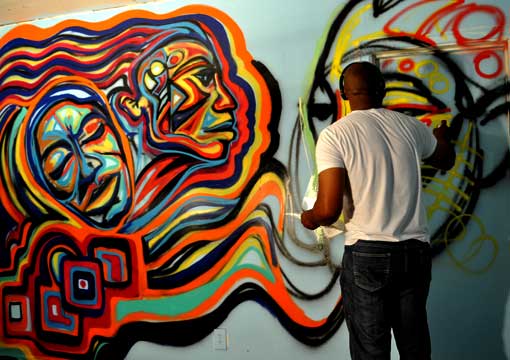
Today the African-American is producing work in every field of art, out of various material from junk to electronic equipment, and many styles and techniques. More and more African-American artists of all races are producing beautiful, sophisticated, contemporary art in a variety of media and making rich contributions to the field of functional art.
America is a blend of many different cultures. This is also true of the modern African-American artist. American education, unfortunately, has stressed his European heritage and not his African. In spite of improved awareness of the outstanding role of African Americans, their artistic work remains greatly ignored and unappreciated today, except in music and the performing arts.
It is necessary to gain an understanding of African- Americans' background in order to fully appreciate the valuable contributions made by the black artists to our American culture. It incumbent upon us to learn about the slave artisans who made the most of whatever opportunities for self-expression came in their direction. We must also discover the impact of Western cultural traditions on African-Americans during three hundred years since they first landed in America. We must also return to the African-Americansõ beginnings in Africa.
As more and more artists set-up their own studios where others could be trained, American art began to develop its distinct characteristics. In the early days of American painting, many artists were self-taught, which may account for the variety and freshness of their work. It is in this setting that we first distinguish one or two black artists by name.
African-American artists tried to express a message of lasting interest that grew out of their American experience. It is because each artistõs personal experience differed from the others' that their works have an individual character that is best understood and appreciated when we learn something of the varied lives of the artists. These experiences had a profound influence on the direction of their work.
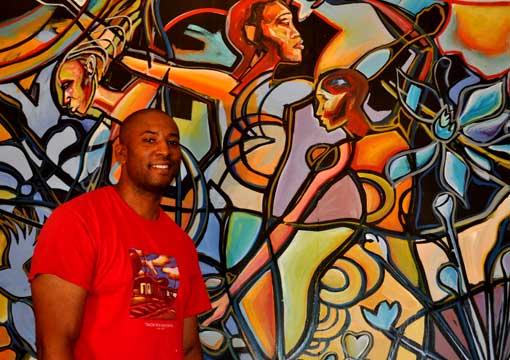
African-American artists had to depend on the enlightened attitudes of a few individuals until patrons of abolitionist groups and the Freedman's Bureau gained prominence in the nineteenth century. Even the talented free African-Americans were subject to all the legal restrictions, social disgrace associated with the slave system. European colonists had rationalized, in order to justify the system, that by nature, temperament, pigmentation and civilization the African-Americanõs natural lot was slavery and he was not fit for anything else, including art.
During colonial days the African-American artist was regarded as something of a curiosity. Since nineteenth-century colonists regarded art as the ultimate expression of a civilized people, African-American artist who identified himself with the creative arts was making a false claim. A few African-Americans of outstanding drive and ability, managed to become artists in spite of the odds. Scipio Moorhead and Joshua Johnston have left their work as evidence. They came from all walks of life and different parts of the United States. Moorhead was a slave in New England. Johnston was a free black in New Orleans.
An advertisement from a Boston newspaper is typical of the scanty information found about the majority of African-American artists before the twentieth century:
Negro artist. At McLeanõs Watch-maker, near Town-Hall, is a Negro man, whose extraordinary genius has been assisted by one of the best Masters in London; he takes faces at the lowest rates.
What was the name of this "extraordinary genius"? How did he manage to obtain an art education in London? Where are his paintings now? The artist mentioned in the ad was an exceptional African-American because few of his race had the advantage to study in Europe. Most were self-taught or had received limited instruction from a patron.
Additional information has been revealed to us about another artist G.W. Hobbs, a Methodist minister who lived in Baltimore around 1784. It is possible that he painted the pastel portrait of Richard Allen, the first bishop of the African Methodist Church. We do not know that Hobbs had established himself in that area. Later, under the leadership of Bishop Daniel Payne, this church became a patron of the arts and did much to encourage talented young African-Americans.
More documentation is available in the nineteenth century on African-American art compared to the colonial period. However, there are still gaps. The work of Robert M. Douglas, Jr. is an example. There is much that is known about his life, however his art has completely vanished. Portraits painted by two African-American artisans named Vidal and Wilson were exhibited in Philadelphia in 1852. They are mentioned as being 3very creditable2.
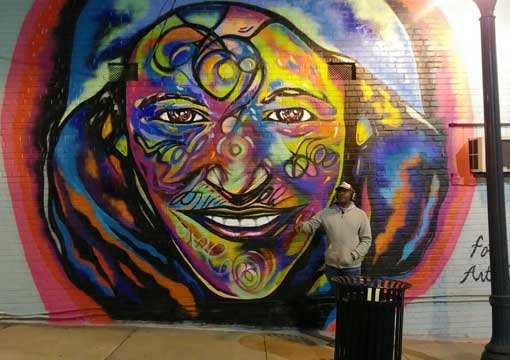
Three other Philadelphia artists were known about the same time as Douglass: William H. Dorsey, John P. Burr, and J.G. Chaplin. Few examples of their work have survived. In addition, the merits of Nelson Primus, A.B. Wilson and Gerritt Loguen remain unknown because few of their works can be found. One black painter, Alexander Pickhil of New Orleans, destroyed nearly all his work in disgust over adverse criticism.
When one considers the difficulties of historical research, and the hardship of identifying the work of artists who many times left pieces unsigned, it is surprising that there are any authentic examples of eighteenth or nineteenth century African-American art. Fortunately, there are some works by African-Americans during this period that have survived.
One artist whose work did survive is Henry Tanner, who was awarded the French Legion of Honor and was the first African-American to be elected a full member of the National Academy of Design in America.
Self-taught painters and sculptors, or "folk artists," turned out work that is called "primitive" because of its lack of professional technique. However, technical excellence in these artistic efforts is more than compensated for by their fresh and original approach and the variety and interest of the subject matter. There is a painting of a horse on one wall, at Stratford Hall, in Virginia. According to tradition, it was done by a slave girl. No one knows her name, nor the circumstances in which it was painted. Also Harley, a slave in South Carolina, was moved to paint the battle of Fort Sumter. And he did a watercolor of the interior of the fort with its neat rows of quarters.
 Two runaway slaves also turned their hands to painting. One, whose name is not known, painted a small oil portrait of A Banjo Player as a gift for the man who helped him escape. Joe, a runaway slave who was employed as a handyman and clerk in a grocery store in Milwaukee, Wisconsin painted a portrait of the grocerõs small daughter and son after his escape.
Two runaway slaves also turned their hands to painting. One, whose name is not known, painted a small oil portrait of A Banjo Player as a gift for the man who helped him escape. Joe, a runaway slave who was employed as a handyman and clerk in a grocery store in Milwaukee, Wisconsin painted a portrait of the grocerõs small daughter and son after his escape.
There may be countless examples of work by African-American painters hanging unnoticed in private collections throughout the country. If only they could be recorded and made available to experts for study, many unidentified African-American artists might be discovered.
J. Hall Pleasants produced enough clues to identify Joshua Johnstonõs work. As a result, numbers of unknown examples of art works were discovered. A painting by David Bustill, the nineteenth-century African-American artist, was recently identified from a photograph. This picture which, had been clearly signed and dated, laid unnoticed in a National Park Service museum. Park Service officials valued it for its subject matter and knew nothing of Bustill except that he was a Negro.
One untapped source of African-American art my be the family portraits owned by African-Americans. Cedric Dover recognized that such paintings should be sought and studied. He believed them to be numerous and cited the Metoyer portraits at Melrose in Natchitoches, Mississippi, as examples. One is signed by Feuville, but whether he was a Frenchman or an African-American is not known. The other two are unsigned.
Regardless of on going investigations results, we know a number of Master African-American artists to whom African-Americans can point with pride.
The following are selected distinguished African-American Masters of American Art.
JOSHUA JOHNSTON (l796-1824)
Although he is the best documented of all the eighteenth African-American artists, Joshua Johnston remains a shadowy painter at best. He was listed in the Baltimore Directory as a portrait painter from l796-1824. Following his death his works were credited to other artists. It has taken massive research for many years to uncover two dozen or more of his paintings.
Thanks to the work of the late Dr. J. Hall Pleasants of the Maryland Historical Society, one can draw a vague portrait of Joshua Johnston that he was a "Free Householder of Colour we know, and that he was first a slave, who later gained his freedom, perhaps earning it through his work as a painter. His work strongly suggests the influence of Charles Peale Polk, a very active portrait painter in Baltimore in the l790's. Tradition in the Moale family, whose portraits he painted, makes him a slave of Colonel John Moale, who lived on German Street in Baltimore. At one time the artist is listed as living on the same street, which gives truth to this story.
Johnston moved frequently and lived at a number of colorful addresses, such as Primrose Alley and Strawberry Lane. He must have been successful when we consider the number of known paintings done by him for wealthy Baltimore families. This indicates exceptional talent when we realize that he must have been self-taught.
Johnston was a primitive painter. His work has a two-dimensional quality and his subjects posed somewhat still and formal poses. However, the simplicity of his style has certain innocent charm.
In all of Johnston's portraits, the poses are similar. The figures have expressionless, pudgy hands and are holding an object. Since the same things appear in different paintings, they were likely props owned and used by the artist. In fact, two different members of the Bankson family are pictured wearing the same earrings.
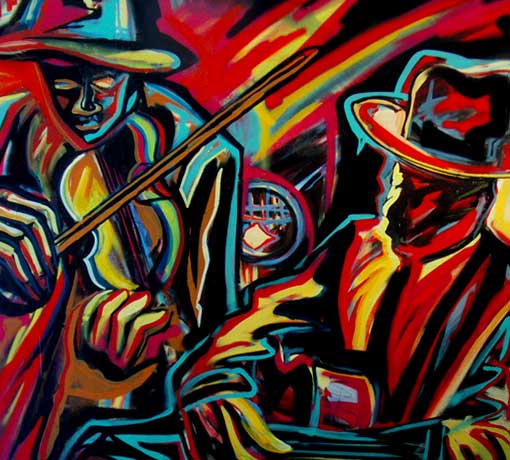
While sittings may have taken place in the artist's studio, it is possible that the props were kept and painted in without the sitter's presences. The faces may have been done separately at the subject's home. Such devices were frequently used by portrait painters to save the sitter's time.
Brass-studded Sheraton sofas and chairs are used frequently in Johnston's paintings. It has been solemnized that this metallic rhythmic use of nails" is an Africanism. However, this seems far-fetched. Had the nails been inserted into the canvas there might be a clearer relationship but since they are merely painted on it is more likely these are the artistõs props.
Several other features make repeated appearances in Johnson's paintings-baskets of strawberries or cherries, a letter, book or map; the same tassel; and a peculiar fuzzy white dog, with a pig like face.
ROBERT S. DUNCANSON (l817-1872)
Robert S. Duncanson, a mulatto of Scots-Canadian decent, was born in New York State. He was educated in Canada. During his early years in Cincinnati, he encountered the usual difficulties of young artists. However, he had the good fortune to be sent to Edinburgh, Scotland, to study at the expense of the Anti-Slavery League. There, according to author Cedric Dover, paternal tradition led him to become "immoderately drunk on Tennyson and Scott." As a result, his painting, "The Lotus Eaters," was born. The picture was based on Tennyson's poem by the same name. He received great acclaim from British art critics, though attempts to locate it have failed.
His first trip to Europe was followed by several others, including study of "classical tradition" in Italy. Throughout Duncanson's trips to Europe, however, he remained an American artist, both in his work and his attitudes. Although he returned several times to Europe, he always returned to America, where he died.
Duncanson received several commissions to paint the portraits of prominent people during his residence in this country. William Freeman Cary, Bishop Payne, and the Berthelets to name a few. He also painted a full length portrait of Nicholas Longworth, who commissioned him to execute a series of murals for the hall and reception room at Belmont, the Longworth mansion (now the Taft Museum) in Cincinnati, Ohio.
A series of sentimental pictures accented Duncansonõs career as a landscape painter. One of his landscape paintings is‹Blue Hole, Flood Waters, Little Miami River, a painting reminiscent of landscapes of the Hudson River School (1851). Though the charm of this picture was never repeated, he did produce several lovely landscapes in the same romantic mood. Other paintings were Ellen's Isle, Loch Katrine, Vale of Kashmir, and Romantic Landscape. Critics disagree in judging both Duncansonõs artistic ability and his character as a person. However, there is little doubt that Duncansonõs career is a milestone in the history of African-American art. He was the first African-American artist to receive widespread recognition both in this country and abroad.
HENRY OSSAWA TANNER (1859-1937)
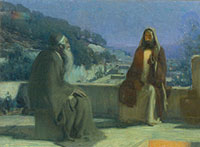 Henry Ossawa Tanner explained his early interest in painting. At the young age of thirteen, while walking in Fairmount Park, Philadelphia, with his father, he was fascinated by the sight of an artist at work. He was so impressed that he rushed home and attempted to copy the same landscape from memory, using house-painterõs brushes on the cardboard back of an old geography book.
Henry Ossawa Tanner explained his early interest in painting. At the young age of thirteen, while walking in Fairmount Park, Philadelphia, with his father, he was fascinated by the sight of an artist at work. He was so impressed that he rushed home and attempted to copy the same landscape from memory, using house-painterõs brushes on the cardboard back of an old geography book.
Tanner pursued his chosen career with such skill and application that even the opposition of his family could not stop him. Bishop Benjamin Tucker Tanner of the African Methodist Episcopal Church, gave him all the support possible, once it was evident that Henryõs interest was genuine. For many years, Henry worked hard at developing his technique, modeling the animals in the zoo in Philadelphia, painting seascapes, and studying under William Chase and Thomas Eakins at the Pennsylvania Academy of Fine Arts, where he received excellent training in draftsmanship and painting techniques.
Eakins, who was a friend and teacher, held that: "If America is to produce great painters and if young art students wish to assume a place in the history of their country, their first desire should be to remain in America, to peer deeper into the heart of American life." This was the highest order of preaching, since at that time it was considered essential to study and work in Europe since it was the fountainhead of all great art.
Tanner failed to heed Eakins's advice. Although, for a short period he taught at Clark College in Atlanta and spent his spare time painting landscapes and the folk of the North Carolina mountains. His work of this period, of which The Banjo Lesson is an example, hinted that at last African-American life would inspire a genre painter who would portray his race with sensitivity and understanding. Unfortunately, this promise was not fulfilled.
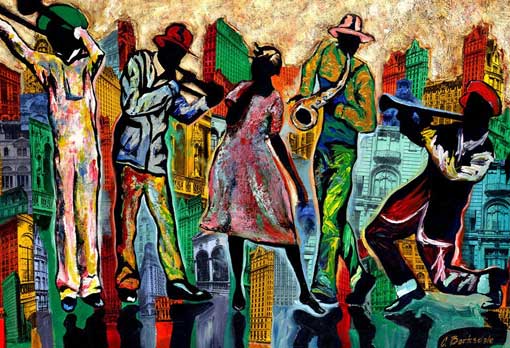
Tanner was very unhappy at Clark College. Friends and admirers encouraged him. But, no doubt he experienced the usual racism, and perhaps mistook the obstacles faced by young artists the world over as further evidence of discrimination. He became convinced he could not succeed in America and became determined to study in Europe. With the help of Bishop Hartzell, who arranged a one-man show for him and who ended up purchasing most of his paintings, Tanner finally succeeded in reaching Paris, France. Here he studied under Benjamin Constant and Jean-Paul Laurens at the Academie Julien.
Tanner developed a mature style grounded on his earlier work with Eakins and his admiration for Rembrant, and he tried his hand at a variety of paintings. During summers in Brittany he painted a number of landscapes. Some of them were Bois dAmour, Evening Near Pont-Aven, Rocks at Concarneau, and Return of the Fishing Boats. He also painted a series of genre paintings of Breton life, which are reminiscent of his earlier pictures of African-Americans in North Carolina. Such paintings as The Bagpipe Lesson and The Sabot Makers show the same sensitivity for his subjects that we find in The Banjo Lesson.
Originally headed for the ministry, and influenced by his father, Bishop Tanner, the artist had deep religious feelings that were expressed in his work. In the Paris Salon of 1896 he received honorable mention for a painting called Daniel in the Lion's Den. With the support of Rodman Wanamaker, Tanner visited Palestine. This trip inspired him to paint a great biblical series that brought him fame. His success with this theme was followed by others in the same sentimental vein.
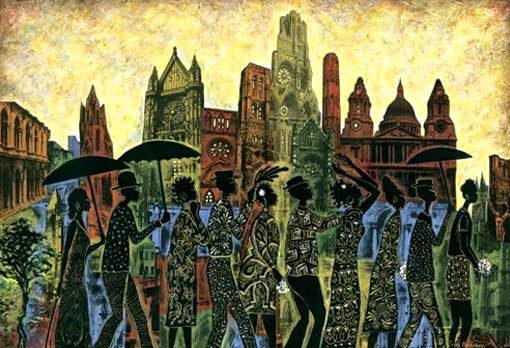
His paintings won prizes in the Paris Salons and were purchased by many American museums, including the Metropolitan Museum of Art in New York, Chicago Art Institute, and the Pennsylvania Academy of Fine Arts. The French Government made him a member of the Legion of Honor. He was also the recipient of a gold medal from the Exposition Universelle International and a bronze medal from the Panama-Pacific International Exposition. Most important of all, he became the first African American to be elected to a full member of the National Academy of Design.
In spite of his recognition and talent, Tanner remained an expatriate for forty-five years. Embittered by sensational publicity about his race, he became a studio recluse. Among his best-known paintings are The Resurrection of Lazarus, The Disciples at the Tomb, Christ Walking on the Water, The Annunciation, and Christ and Nicodemus.
Recently some one hundred and fifty drawings, lithographs, etchings, and watercolors, were discovered which lay unnoticed for almost forty years in Tanner's dusty old studio in Paris. This cache of paintings reveal new dimensions in his work. No matter what the final judgment of Tanner's work, the honors accumulated by him in his life place him in a unique position in American art.
HORACE PIPPIN (1888-1946)
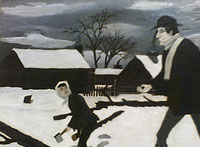 Sculptor, painter. Horace Pippin was born in West Chester, Pennsylvania. He completed his first painting at forty-three years of age. After spending fourteen months in the trenches during World War I, Horace Pippin was wounded in his right shoulder, and his arm was considered useless. However, using his left hand to prop up his right, he began to paint and in three years had completed his first painting: End of the War-Starting Home. His first group of paintings all dealt with his striking memories and impressions of war. They have the simplicity of the self-taught artist, with the color applied mostly in flat areas. There is an obvious feeling for design that characterize work by most of the better "primitives." Pippinõs later works are regimented into patterned areas that are intensified by accents of pure white. "Pictures just come to my mind," he once explained, 3and I tell my heart to go ahead.
Sculptor, painter. Horace Pippin was born in West Chester, Pennsylvania. He completed his first painting at forty-three years of age. After spending fourteen months in the trenches during World War I, Horace Pippin was wounded in his right shoulder, and his arm was considered useless. However, using his left hand to prop up his right, he began to paint and in three years had completed his first painting: End of the War-Starting Home. His first group of paintings all dealt with his striking memories and impressions of war. They have the simplicity of the self-taught artist, with the color applied mostly in flat areas. There is an obvious feeling for design that characterize work by most of the better "primitives." Pippinõs later works are regimented into patterned areas that are intensified by accents of pure white. "Pictures just come to my mind," he once explained, 3and I tell my heart to go ahead.
AUGUSTA SAVAGE (1900-1962)
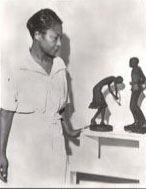 Augusta Savage was a world-famous African-American sculptor. Born in Florida, she had her first formal art training in New York City at Cooper Union, the school recommended to her by Solon Gorglum. While she studied, she supported herself by doing odd jobs, including clerking and working in laundries. In 1926 she exhibited her work at the Sesquicentennial Exposition in Philadelphia. That same year she was awarded a scholarship to study in Rome. However, she was unable to accept the award because she could not raise the money she would have needed to live there. Later, she did study in Europe.
Augusta Savage was a world-famous African-American sculptor. Born in Florida, she had her first formal art training in New York City at Cooper Union, the school recommended to her by Solon Gorglum. While she studied, she supported herself by doing odd jobs, including clerking and working in laundries. In 1926 she exhibited her work at the Sesquicentennial Exposition in Philadelphia. That same year she was awarded a scholarship to study in Rome. However, she was unable to accept the award because she could not raise the money she would have needed to live there. Later, she did study in Europe.
When she returned to the United States, she exhibited her work at several important galleries. In addition to her own work, Augusta Savage taught art classes in Harlem. During the Depression, she helped African- American artists to enroll in the Works Progress Administration arts project. Throughout her career, she was an active spokesperson for African-American artists in the United States. She also was one of the principal organizers of the Harlem Artists Guild.
WILLIAM H. JOHNSON (1901-1970)
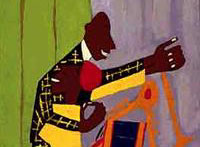 William Johnson was born in lay in Florence, South Carolina. He was inspired to be an artist at an early age, despite of his poverty and lack of education. At the age of seventeen, he went to New York and worked at various jobs to pay for his training at the National Academy of Design. In l942, he went to Paris to study after winning a number of prizes in art shows.
William Johnson was born in lay in Florence, South Carolina. He was inspired to be an artist at an early age, despite of his poverty and lack of education. At the age of seventeen, he went to New York and worked at various jobs to pay for his training at the National Academy of Design. In l942, he went to Paris to study after winning a number of prizes in art shows.
He lived abroad for twelve years in France, Scandinavia, and North Africa and married Danish weaver Holca Krake. With the outbreak of World War II, Johnson returned to the United States where he became well-known for his bright, bold paintings of African-Americans. He died in l970.
JACOB LAWRENCE (1917- ) 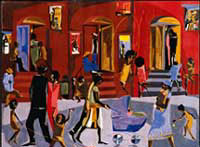
Jacob Lawrence was born in Atlantic City, New Jersey. He studied at the Art Workshop, Harlem, under Charles Alston and Henry Bannan. He also, studied at the Harlem Art Center and American Artists School from l937-39.
Like many other artists of social protest in the thirties and forties, Lawrence began his career in a settlement house art class and was supported by the Depression-born W.P.A. in his early years. According to author David Driskell, "Jacob Lawrence has looked at history with the discerning eye of a sensitive critic. He has recorded a visual record which touches upon our national and ancestral interests.
It is obviously noticeable that his paintings contain some of the visual symbols associated with man's protest against the intolerable conditions that often beset him, but they also present to us a segment of reality which ties our lives to history that is reflected in the immediate drama of everyday living. This is the reason why his style in art cannot be crammed into the usual bag of modern "isms". Thus, he distinguishes himself as an artist who is highly sensitive to the conditions of life that face all mankind."
One cannot fully understand his or her past, nor control his/her future, without knowing something about his/her past. A large number of my students are not aware of outstanding contributions to American Art made by African-Americans. The following lessons are designed to expose them to artistic and cultural expressions among artists, to expand their knowledge, and to help develop positive self-esteem.
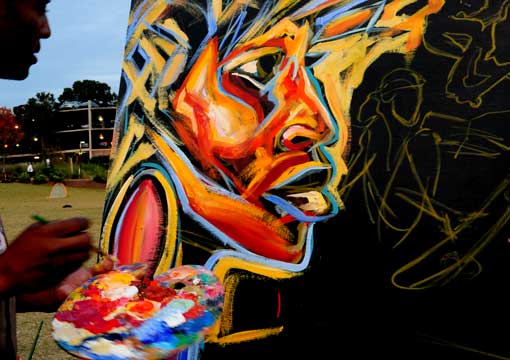
_________________________________________________________________________
Atlanta Performance Live Art Street Art by Black Artist Corey Barksdale- Downtown Atlanta, Georgia Art
_________________________________________________________________________
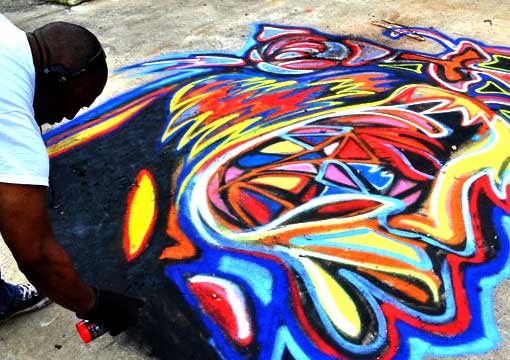
_________________________________________________________________________
Atlanta Performance Live Art Street Art - Downtown Atlanta, Georgia
_________________________________________________________________________
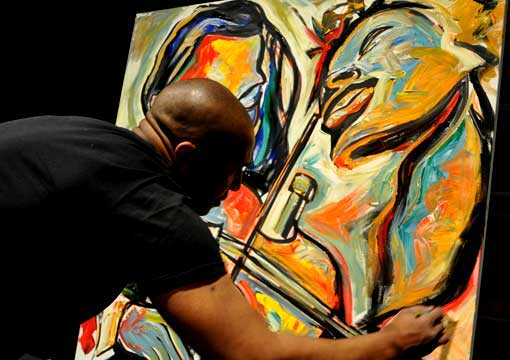
_________________________________________________________________________
Atlanta Performance Art Atlanta Furniture Bank Chairish the Future 2013
_________________________________________________________________________